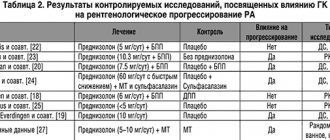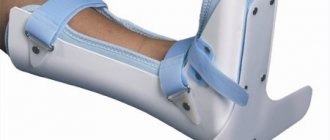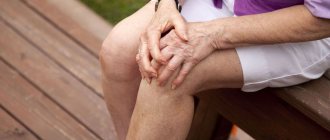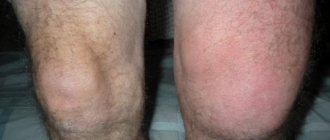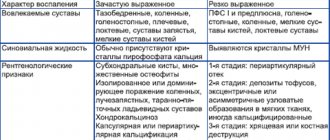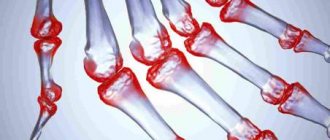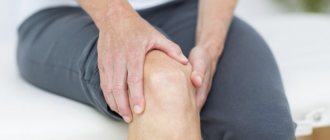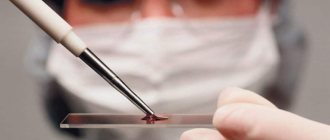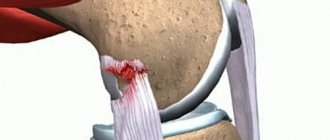Joint pain can make life unbearable. After visiting a doctor, a record of diagnosed arthrosis or arthritis will appear in the outpatient card.
People who are far from medicine have little idea of the difference between arthritis and arthrosis, and mistakenly consider them to be the same disease.
In fact, these are two completely different pathological processes that can occur simultaneously.
Arthrosis
Arthrosis refers to degenerative-inflammatory processes and develops due to age-related changes in the structure of cartilage tissue.
It affects the moving joints of large bones, and less commonly, the joints of the fingers.
Appearance of a joint with arthrosis
The main cause of pathological changes is metabolic disorders in the cartilage. Violation of cartilage trophism leads to irreversible loss of proteoglycans and loss of tissue elasticity.
Dystrophic changes in cartilage entail pathological changes in the structure of the articular surfaces of bones. Over time, the degeneration process spreads to the periarticular tissues.
Types of arthrosis
Based on their origin, they distinguish between primary and secondary arthrosis.
Primary
the form affects previously healthy joints and is a consequence of age-related changes and inadequate physical activity. The timing of the appearance of the first symptoms of arthrosis depends on hereditary predisposition, characteristics of professional activity, and lifestyle.
Traditionally, people over 45 years of age are considered at risk, but now there is a steady trend towards early incidence. The disease affects mainly women, but with age, the dependence on gender gradually smoothes out.
Secondary arthrosis
develops against the background of a previous injury or certain diseases of different nature, including:
- autoimmune processes;
- metabolic disorders;
- endocrine dysfunction;
- pathologies of the structure of bone joints;
- genetic diseases;
- inflammatory processes.
Secondary arthrosis is not associated with the aging process and can occur at any age.
There are three stages in the development of the disease.
At the first stage, changes in the joint fluid occur. The nutrition of the cartilage is disrupted, and its resistance to stress decreases. Roughness appears on the surface of the cartilage, and inflammation develops, accompanied by pain.
As the disease progresses to the second stage, the pain becomes habitual, and the course of the accompanying inflammation becomes wave-like. The cartilage begins to deteriorate, and compensatory bone growths form at the edges of the articular area. Periarticular muscles are involved in pathological processes.
The third stage is characterized by severe depletion of articular cartilage with areas of complete tissue destruction. Degenerative processes lead to irreversible anatomical changes, including changes in the axis of the limb. The function of the ligamentous apparatus is disrupted, abnormal mobility appears in the affected joint against the background of limited natural mobility.
According to the location of the lesion, they are distinguished:
- gonarthrosis,
- coxarthrosis,
- spondyloarthrosis,
- arthrosis of the interphalangeal joints of the hands.
Other localizations of pathology are relatively rare.
Causes of the disease
As paradoxical as it sounds, the disease affects older people much less often than young people and even children. This disease is quite insidious and difficult to diagnose, especially in the case of damage to the knee joints. And the reason is that it is an inflammatory process caused by various types of infections. Most often, the causative agents are staphylococci of various types, but there are also candida bacteria and other pathogens.
It seems that the immune system of young people is much stronger than the elderly, and they are much more active in movement and a priori should not suffer from joint pain. But doctors state that a tenth of young people have joint damage, and even children under one year of age suffer from it. Why is this happening? Modern doctors do not give a clear answer to this question. But the main causes of joint inflammatory infections are called:
- consequences of injury;
- diseases of the central nervous system;
- hip dysplasia;
- diseases caused by infections;
- unhealthy food and extra pounds;
- hereditary predisposition;
- disruptions in the hormonal system.
To determine the type of arthritis, the doctor must prescribe a diagnosis and, based on the results, refer you to a doctor who treats these diseases.
These are just some of the causes of the disease. To determine the type of inflammatory infection, the doctor must prescribe a diagnosis and, based on the results, refer you to a doctor who treats these diseases.
Gonarthrosis, arthrosis of the knee joint
Risk factors for the development of this disease include hereditary predisposition, overuse or knee injuries due to occupational characteristics.
According to statistics, arthrosis lesions in the knee joints are more often diagnosed in women.
In the early stages of development, the disease manifests itself as discomfort in the affected joint and aching pain. Depending on the causes of the lesion, several forms of gonarthrosis are distinguished.
Some of them are characterized by a long-term lack of progression; the patient’s condition remains stable for decades. However, there are also those that develop rapidly and lead to loss of mobility of the affected limb.
Symptoms of the disease and choosing a specialist
Arthritis is an inflammatory process and its threat is that not only the joints are affected, but also other organs, especially the liver, kidneys, and heart. The disease is divided into several categories, but each has common symptoms:
- Swelling.
- Redness of the diseased organ.
- Pain that gets worse at night.
All these indicators indicate the presence of infection and a malfunction of the immune system when it begins to fight against its own body.
The ideal option if you suspect the development of the disease would be to visit an arthrologist.
Arthritis can be primary or secondary, as a consequence of other diseases.
Primary is characterized as an independent disease, without obvious pathological damage to the body by other diseases.
- Rheumatoid – affects small joints, constraining them and limiting movement, a “tight glove” effect, accompanied by pain, swelling, and morning stiffness.
- Juvenile – covers elbows, knees, ankles. Children under 16 years of age are susceptible to it. Dangerous due to impaired development of skeletal bones and growth.
What kind of doctor treats these diseases? Of course, the ideal option would be to visit an arthrologist. This doctor specializes exclusively in the diagnosis and treatment of joint pathologies, as well as their prevention.
If you suspect rheumatoid type or lupus, then you need to go to a rheumatologist. But, given that this specialization is quite narrow, and not every clinic has doctors of this profile, then first of all you need to go to a therapist, and in childhood, to a pediatrician.
If the disease is primary, it is treated by one of the above-mentioned specialists. Rheumatoid and juvenile arthritis require consultation with an immunologist, since the root cause of its development is the body's autoimmune reaction.
If you suspect the rheumatoid variety or lupus, then you need to go to a doctor - a rheumatologist. Gout is the accumulation of salts in the joint tissues with the formation of tophi. It most often affects the big toe.
Gout requires treatment in parallel with the nephrologist’s prescriptions, due to the fact that its development is provoked by kidney disease. In addition, you will need to go to a doctor-nutritionist, since uncontrolled consumption of chocolate products, natural coffee, strong tea, alcoholic drinks, and protein foods can trigger a relapse.
- Spondylitis is inflammation of the vertebrae. It is characterized by limitation of the motor function of the spine, up to paralysis, changes in the physiological structure of the spinal column and its deformation.
- Osteoarthritis is the destruction of cartilage on the surface of a joint. It is fraught with irreversible restrictions on motor activity.
If the source of pain is concentrated in the area of the spinal column, then consultation with a vertebrologist is necessary. He is the one who treats spinal pathologies. But such doctors are also quite rare. If it is not possible to see a specialist doctor, then the first step is to visit a therapist who will determine the further course of treatment.
Coxathrosis, arthrosis of the hip joint
With this disease, a classic clinical picture of arthrosis is observed. The first symptom of coxarthrosis is discomfort in the hip joint after physical activity.
With progressive coxarthrosis, pain increases, stiffness and limited mobility appear. Patients with a severe form of coxarthrosis spare the affected limb, avoiding stepping on it, and while stationary, choose positions in which the pain is felt the least.
Drug therapy
Nonsteroidal drugs, antibiotics, and chondroprotectors are used in the treatment of arthritis. Anti-inflammatory drugs relieve inflammation, reduce swelling and pain. If necessary, a puncture of the inflamed area is performed, and antibiotics and steroid hormones (Dexamethasone, Kenalog) are injected into the joint cavity. The affected cartilage tissue is restored with the help of chondroprotectors. Arthritis of the feet and fingers can be successfully treated with ointments, gels, and creams with anti-inflammatory and cooling effects.
In advanced cases, surgical intervention is possible to replace the diseased joint using artificial materials. Thus, for arthritis of the knee joint, replantation or reconstructive surgery will help restore the diseased joint and prevent further development of the disease.
IMPORTANT! During treatment, it is necessary to reduce the load on the diseased joints as much as possible: long walking and heavy lifting are excluded.
Exercise therapy and physiotherapeutic procedures
Drug treatment should be carried out in combination with physiotherapy and exercise therapy.
Physiotherapeutic procedures include:
- diadynamic;
- electrophoresis;
- magnetic therapy;
- mud - and paraffin treatment.
IMPORTANT! All activities are carried out during the remission process. For arthritis of the foot, exercises are performed only in a lying position.
Orthopedic devices
Treatment of arthritis of the knee joint and feet never takes place without auxiliary orthopedic devices and shoes. A regular cane, knee pad, and tight bandage will help reduce the load on the inflamed area and reduce pain.
Special energy-absorbing shoes should have hard or convex soles.
Diet
An important aspect of treating arthritis is proper nutrition. A nutritionist will help you create the right daily diet, which will include vegetables, fruits, cereals cooked in water, as well as foods rich in calcium. It is better to avoid eating fatty, salty foods, meat, and offal.
Treatment of arthrosis
It is impossible to cure arthrosis completely with modern medicine. However, timely diagnosis and complex therapy aimed at preventing further destruction of cartilage tissue help stabilize the condition of the affected joint and significantly improve the patient’s quality of life.
First of all, it is necessary to reduce the load on the musculoskeletal system. Doctors recommend avoiding carrying heavy objects, staying in one position for a long time, and limiting time on your feet. For overweight patients, it is vital to lose weight.
In the drug treatment of arthrosis, the following is used:
- non-steroidal anti-inflammatory drugs, such as diclofenac, nimesulide, ibuprofen, internally in the form of injections or tablets and externally as part of ointments. The form and regimen of use are prescribed depending on the patient’s condition;
- drugs from the group of chondroprotectors to maintain the condition of cartilage tissue;
- steroidal anti-inflammatory drugs in the form of intra-articular injections. Prescribed in severe cases;
- hyaluronic acid preparations to improve joint mobility.
Additionally, warming compresses and ointments, drugs that activate blood microcirculation and metabolic processes, antioxidants and microelement-vitamin complexes with selenium are used, and physiotherapeutic treatment is prescribed. In severe cases, it is necessary to resort to surgical intervention.
During the period of remission, the patient is recommended a course of exercise therapy, selected in accordance with the characteristics of the course of the disease.
For more information about treatment methods, see:
- surgical treatment of arthrosis
- joint replacement
Causes of the disease
The disease can develop very slowly (chronic form) or quickly and unexpectedly (acute phase). The cause can be any pathological process in our body. That is why it is very important to seek help from a specialist and find out which doctor treats the disease.
Medical research identifies several main causes of arthritis:
- infectious diseases;
- hypothermia;
- limb injuries;
- specific lesions of articular tissue;
- gout;
- immune system disorder;
- heredity.
Treatment
The main therapy is aimed at relieving pain, inflammation, restoring motor function, and identifying the cause of the disease. Often, after treatment of the underlying disease, remission and complete recovery occur.
The classic treatment regimen for arthritis of any etiology includes:
- Drug therapy.
- Exercise therapy.
- Diet.
- Orthopedic devices.
- Physiotherapy.
- Taking vitamin complexes.
IMPORTANT! Treatment with folk remedies is allowed, but only during a lull in the disease.
Arthritis
Arthritis is an inflammatory disease that occurs as an underlying disease, a concomitant pathology, or as a complication of a previous infectious disease.
Appearance of joints with arthritis
Among the typical causes of inflammatory processes in the joints:
- metabolic disorders in the body;
- lack of vitamins;
- injuries;
- autoimmune diseases;
- infectious lesions of various etiologies.
Unlike arthrosis, pathological processes in arthritis affect the periarticular tissues. The appearance of pain does not depend on physical activity and body position, and often bothers you at night.
Noises in the joints characteristic of the early stages of arthrosis are rarely observed. A general blood test indicates the presence of an inflammatory process; when examining joints, characteristic degenerative changes in cartilage are rarely detected.
The common symptom of both diseases is pain. Any unusual and unpleasant sensations in the joints are a good reason to consult a doctor. The success of treatment largely depends on timely detection and treatment of the disease.
Types of Arthritis
Based on their occurrence, arthritis is divided into several types:
- infectious arthritis. They develop as independent diseases due to infection of wounds (primary infectious arthritis) or when a pathogen enters the bloodstream from organs affected by infection (secondary arthritis);
- rheumatoid arthritis. This chronic disease is of infectious-autoimmune origin and usually develops in people of middle age and older;
- gouty arthritis. The inflammatory process is provoked by microtraumatization of the surface of the cartilage by crystals of uric acid salts formed in the joint capsule;
- traumatic arthritis develops as a reaction to injury, but can develop several years after its consequences have been eliminated;
- Juvenile rheumatoid arthritis affects children under 16 years of age. The causes of this disease are not yet known. The course is chronic, progressive.
The course of arthritis can be acute or chronic. In the acute course, the disease develops quickly, with severe swelling, severe pain in the affected area, local or general increase in temperature.
With chronic arthritis, symptoms increase gradually, and the disease can progress over years. With untimely or inappropriate treatment, acute arthritis can become chronic.
According to the characteristics of the lesion, monoarthritis and polyarthritis are distinguished. In monoarthritis, the lesion is localized on one of the joints; when several joints are involved in the pathological process, a diagnosis of polyarthritis is made.
Arthritis treatment
The treatment strategy for arthritis depends on the causes of the disease and the severity of the patient's condition. For infectious arthritis, patients are prescribed a course of antibiotics or other drugs, in accordance with the nature of the pathogen.
To eliminate inflammation, non-steroidal anti-inflammatory drugs are used in the form of injections, tablets and/or externally in the form of an ointment or gel.
Additionally, drugs from the groups of chondroprotectors, antihistamines, and general restoratives may be prescribed. In some cases, patients are prescribed drugs that improve blood microcirculation.
In addition to drug treatment, patients are prescribed a course of physiotherapeutic procedures and, during the period of remission, a set of exercise therapy exercises.
In severe and advanced cases, surgery may be required.
Without the help of specialists, arthritis and arthrosis can lead to disability.
Self-medication for joint diseases is contraindicated; in the vast majority of cases, the patient’s condition progressively worsens.
Any change in the functionality of the joint is a reason to visit a doctor.
How to recognize the disease?
Before looking for help in a clinic or hospital, you need to roughly understand what is happening to the body; it is advisable to know the signs of an emerging problem, so as not to trigger the disease and go to a specialist who treats arthritis. What kind of doctor is needed for this? After all, as everyone knows, it is much easier to be treated in the initial stage, and not in the advanced version.
With initial arthritis, joint pain is not very severe, only after serious physical exertion. Often people do not pay attention to this sign, thinking that the pain came simply from fatigue and overexertion. Later, the pain will not subside even with complete rest of the body, especially at night.
Simultaneously with the pain, a person hears a crunching sound and feels stiffness in the movements of the joint. With arthritis, you can experience many accompanying symptoms that affect the entire body. The temperature rises, the size of the tissue around the joint increases, there is drowsiness, weakness, unpleasant discharge from the genitals and even skin psoriasis may appear. Having such different symptoms of arthritis, a person does not always understand which doctor to contact.
